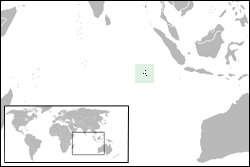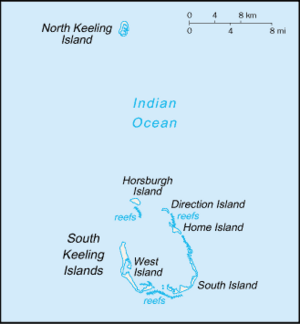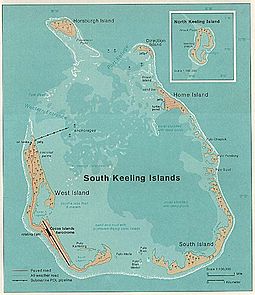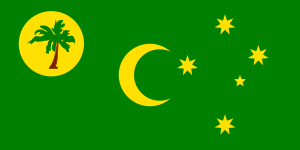Difference between revisions of "Cocos (Keeling) Islands" - New World Encyclopedia
Mary Anglin (talk | contribs) (fix function) |
m |
||
| Line 40: | Line 40: | ||
}} | }} | ||
| − | The '''Territory of Cocos (Keeling) Islands''', also called '''Cocos Islands''' and '''Keeling Islands''', is a [[States and territories of Australia|territory of Australia]]. There are two [[atoll]]s and twenty-seven coral islands in the group. The [[island]]s are located in the [[Indian Ocean]], about one-half of the way from Australia to [[Sri Lanka]], at {{coor dm|12|07|S|96|54|E|region:AU}}. | + | The '''Territory of Cocos (Keeling) Islands''', also called '''Cocos Islands''' and '''Keeling Islands''', is a [[States and territories of Australia|territory of Australia]]. There are two [[atoll]]s and twenty-seven coral islands in the group. The [[island]]s are located in the [[Indian Ocean]], about one-half of the way from Australia to [[Sri Lanka]], at {{coor dm|12|07|S|96|54|E|region:AU}}. ..... |
==History== | ==History== | ||
Revision as of 14:11, 2 September 2007
| Territory of the Cocos (Keeling) Islands | |||||
| |||||
|
The Cocos (Keeling) Islands are one of Australia's territories | |||||
| Capital | West Island | ||||
|---|---|---|---|---|---|
| Official languages | English (de facto) | ||||
| Government | Federal constitutional monarchy | ||||
| - Queen | Elizabeth II | ||||
| - Administrator | Neil Lucas | ||||
| Territory of Australia | |||||
| - Annexed by British Empire |
1857 | ||||
| - Transferred to Australian control |
1955 | ||||
| Area | |||||
| - Total | 14 km² 5.3 sq mi | ||||
| - Water (%) | 0 | ||||
| Population | |||||
| - 2004 estimate | 628 | ||||
| - Density | n/a/km² n/a/sq mi | ||||
| Currency | Australian dollar (AUD)
| ||||
| Internet TLD | .cc | ||||
| Calling code | +61 891 | ||||
The Territory of Cocos (Keeling) Islands, also called Cocos Islands and Keeling Islands, is a territory of Australia. There are two atolls and twenty-seven coral islands in the group. The islands are located in the Indian Ocean, about one-half of the way from Australia to Sri Lanka, at 12°07′S 96°54′E. .....
History
Captain William Keeling was the first European to see the islands, in 1609, but they remained uninhabited until the nineteenth century, when they became a possession of the Clunies-Ross Family. Slaves were brought to work the coconut plantation from Indonesia, the Cape of Good Hope and East Asia by Alexander Hare who had taken part in Stamford Raffles' takeover of Java in 1811. A Scottish merchant seaman called Captain John Clunies-Ross, who had also served under Raffles in the takeover, set up a compound and Hare's severely mistreated slaves soon escaped to work under better conditions for Clunies-Ross.
On April 1 1836, HMS Beagle under Captain Robert FitzRoy arrived to take soundings establishing the profile of the atoll. To the young naturalist Charles Darwin, who was on the ship, the results supported a theory he had developed of how atolls formed. He studied the natural history of the islands and collected specimens. His assistant Syms Covington noted that "an Englishman (he was of course Scottish)and HIS family, with about sixty or seventy Mulattos from the Cape of Good Hope, live on one of the islands. Captain Ross, the governor, is now absent at the Cape."
The islands were annexed to the British Empire in 1857. In 1867, their administration was placed under the Straits Settlements, which included Penang, Malacca and Singapore. Queen Victoria granted the islands in perpetuity to the Clunies-Ross family in 1886. The Cocos Islands under the Clunies-Ross family have been cited as an example of a nineteenth century micronation.
On November 9, 1914, the islands became the site of the Battle of Cocos, one of the first naval battles of World War I. The telegraph station on Direction Island, a vital link between the United Kingdom, Australia and New Zealand, was attacked by the German light cruiser SMS Emden, which was then in turn destroyed by the Australian cruiser, HMAS Sydney [1].
During World War II, the cable station was once again a vital link. Allied planners noted that the islands might be seized as a base for enemy German raider cruisers operating in the Indian Ocean. Following Japan's entry into the war, Japanese forces occupied neighbouring islands. To avoid drawing their attention to the Cocos cable station and its islands' garrison, the seaplane anchorage between Direction and Horsburgh Islands was not used. Radio transmitters were also kept silent, except in emergencies.
After the Fall of Singapore in 1942, the islands were administered from Ceylon (Sri Lanka), and West and Direction Islands were placed under Allied military administration. The islands' garrison initially consisted of a platoon from the British Army's King's African Rifles, located on Horsburgh Island, with 2 × 6 in (152 mm) guns to cover the anchorage. The local inhabitants all lived on Home Island. Despite the importance of the islands as a communication centre, the Japanese made no attempt either to raid or to occupy them and contented themselves with sending over a reconnaissance aircraft about once a month.
On the night of 8-9 May 1942, fifteen members of the garrison, from the Ceylon Defence Force mutinied, under the leadership of Gratien Fernando. The mutineers were said to have been provoked by the attitude of their British officers, and were also supposedly inspired by anti-imperialist beliefs. They attempted to take control of the gun battery on the islands.
The Cocos Islands Mutiny was crushed, although they killed one non-mutinous soldier and wounded one officer. Seven of the mutineers were sentenced to death at a trial which was later alleged to have been improperly conducted. Four of the sentences were commuted, but three men were executed, including Fernando. These were to be the only British Commonwealth soldiers to be executed for mutiny during the Second World War.
On December 25 1942, the Japanese submarine I-166 bombarded the islands but caused no damage.
Later in the war two airstrips were built and three bomber squadrons were moved to the islands to conduct raids against Japanese targets in South East Asia and to provide support during the reinvasion of Malaya and reconquest of Singapore. They included some Liberator bombers from No. 321 (Netherlands East Indies) Squadron RAAF (members of exiled Dutch forces serving with the Royal Australian Air Force), which were also stationed on the islands. When in July 1945, No. 99 and No. 356 RAF squadrons arrived on West Island they brought with them a daily newspaper called Atoll which contained news of what was happening in the outside world. Run by airmen in their off-duty hours, it achieved fame when dropped by Liberator bombers on POW camps over the heads of the Japanese guards. In 1946 the administration of the islands reverted to Singapore.
On November 23 1955, the islands were transferred to Australian control under the Cocos (Keeling) Islands Act 1955. In the 1970s, Australian government dissatisfaction with the Clunies-Ross feudal style of rule of the island increased. In 1978, Australia forced the family to sell the islands for the sum of AU$6,250,000, using the threat of compulsory acquisition. By agreement the family retained ownership of Oceania House, their home on the island. However, in 1983 the Australian government moved to dishonour this agreement, and told the former last ruler, John Clunies-Ross, that he should leave the Cocos. The following year the High Court of Australia ruled that resumption of Oceania House was unlawful, but the Australian government ordered that no government business was to be granted to his shipping company, an action which contributed to his bankruptcy. John Clunies-Ross lives in exile in Perth, Australia, but his successors still live on the Cocos.
Geography
The Cocos (Keeling) Islands consist of two flat, low-lying coral atolls with an area of 14.2 km² (5.4 sq. mi), 2.6 km (1.6 mi) of coastline, a highest elevation of 5 m (16 ft) and thickly covered with coconut palms and other vegetation. The climate is pleasant, moderated by the southeast trade winds for about nine months of the year and with moderate rainfall. Cyclones may occur in the early months of the year.
North Keeling Island is an atoll consisting of just one C-shaped island, a nearly closed atoll ring with a small opening into the lagoon, about 50 m (165 ft) wide, on the East side. The island measures 1.1 km² (272 acres) in land area and is uninhabited. The lagoon is about 0.5 km² (124 acres). North Keeling Island and the surrounding sea to 1.5 km from shore form the Pulu Keeling National Park, established on 12 December 1995.
South Keeling Islands is an atoll consisting of twenty-six individual islets forming an incomplete atoll ring, with a total land area of 13.1 km² (5.1 sq mi). Only Home Island and West Island are populated. People from Home Island maintain weekend shacks on the lagoon shore of South Island and on some of the smaller islands.
Table of the islets, with areas, numbered islets clockwise starting in the north:
| No. | Islet | Area (km²) | |
|---|---|---|---|
| Malay name | English name | ||
| 1 | Pulo Luar | Horsburgh Island | 1,04 |
| 2 | Pulo Tikus | Direction Island | 0,34 |
| 3 | Pulo Pasir | Workhouse Island | 0,00 |
| 4 | Pulo Beras | Prison Island | 0,02 |
| 5 | Button Islets | 0,00 | |
| 7 | Pulo Gangsa | <0,01 | |
| 8 | Pulo Selma | Home Island | 0,95 |
| 9 | Pulo Ampang Kechil | Scaevola Islet | <0,01 |
| 10 | Pulo Ampang | 0,06 | |
| 11 | Pulo Wa-idas | Ampang Minor | 0,02 |
| 12 | Pulo Blekok | 0,03 | |
| 13 | Pulo Kembang | 0,04 | |
| 14 | Pulo Cheplok | Gooseberry Island | <0,01 |
| 15 | Pulo Pandan | Misery Island | 0,24 |
| 16 | Pulo Siput | Goat Island | 0,10 |
| 17 | Pulo Jambatan | <0,01 | |
| 18 | Pulo Labu | 0,04 | |
| 19 | Pulo Atas | South Island | 3,63 |
| 20 | Pulo Kelapa Satu | 0,02 | |
| 21 | Pulo Blan | East Cay | 0,03 |
| 22 | Pulo Blan Madar | Burial Island | 0,03 |
| 23 | Pulo Maria | West Cay | 0,01 |
| 24 | Pulo Kambling | ?Turtle Island | <0,01 |
| 25 | Pulo Panjang | West Island | 6,23 |
| 26 | Pulo Wak Bangka | ?Turtle Island | 0,22 |
The islands with zero areas have vanished.
There are no rivers or lakes on either atoll; fresh water resources are limited to rainwater accumulations in natural underground reservoirs.
Cocos (Keeling) Island is located on almost exactly the opposite side of the globe as Cocos Island, Costa Rica.
Fauna
Demographics
As of 2004, there are 629 inhabitants of the Cocos (Keeling) islands. The population on the two inhabited islands generally is split between the ethnic Europeans on West Island (est. pop. 120) and the ethnic Malays on Home Island (est. pop. 500). A Cocos dialect of Malay and English are the main languages spoken and 80% of Cocos Islanders are Sunni Muslim.
Government
The capital of the Territory of Cocos (Keeling) Islands is West Island while the largest settlement is the village of Bantam (Home Island). Governance of the islands is based on the Cocos (Keeling) Islands Act 1955 [2] [3] and depends heavily on the laws of Australia. The islands are administered from Canberra by the Department of Transport and Regional Services, through a non-resident Administrator appointed by the Governor-General. The current Administrator is Neil Lucas PSM , who was appointed on 30 January 2006 and is also the Administrator of Christmas Island. These two Territories comprise Australia's Indian Ocean Territories. There also exists a unicameral Cocos (Keeling) Islands Shire Council with seven seats. A full term lasts four years, though elections are held every two years; approximately half the members retire each two years. Federally, Cocos (Keeling) Islanders form the electorate of Lingiari with Christmas Island and outback Northern Territory.
The islands have a five-person police force but their defence remains the responsibility of Australia.
Economy
Grown throughout the islands, coconuts are the sole cash crop. Copra and fresh coconuts are the major export earners. Small local gardens and fishing contribute to the food supply, but additional food and most other necessities must be imported from Australia. There is a small but growing tourist industry.
The Cocos Islands Cooperative Society Ltd. employs construction workers, stevedores, and lighterage worker operations. Tourism employs others. The unemployment rate was estimated at 60% in 2000.[1]
The islands are connected within Australia's telecommunication system (with number range +61 8 9162 xxxx) and postal system (post code: 6799). There is one paved airport (on the West Island to which National Jet Systems operate scheduled jet services from Perth, Western Australia) and a lagoon anchorage.
The region's internet top-level domain is .cc.
- Keelingsunset.JPG
Sunset over the islands
- Keelingpalms.jpg
Palm trees on the islands
See also
- Cocos Malays
- Pearl Islands Isla de Cocos, Panama and Cocos Island, Costa Rica
External links
- Atoll Research Bulletin vol. 403
- Cocos (Keeling) Islands Tourism website
- Cocos (Keeling) Islands entry from the CIA World Factbook
- Shire of Cocos (Keeling) Islands
- Noel Crusz, The Cocos Islands mutiny, Reviewed by: PETER STANLEY, Principal Historian, Australian War Memorial
- History of Cocos (Keeling) Islands
- Areas of individual islets
- The man who lost a 'coral kingdom'
| ||||||||||
Credits
New World Encyclopedia writers and editors rewrote and completed the Wikipedia article in accordance with New World Encyclopedia standards. This article abides by terms of the Creative Commons CC-by-sa 3.0 License (CC-by-sa), which may be used and disseminated with proper attribution. Credit is due under the terms of this license that can reference both the New World Encyclopedia contributors and the selfless volunteer contributors of the Wikimedia Foundation. To cite this article click here for a list of acceptable citing formats.The history of earlier contributions by wikipedians is accessible to researchers here:
The history of this article since it was imported to New World Encyclopedia:
Note: Some restrictions may apply to use of individual images which are separately licensed.




